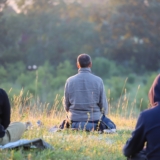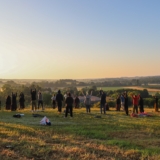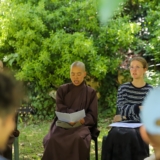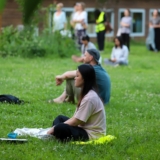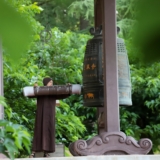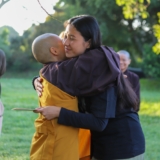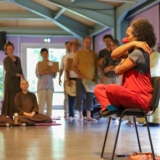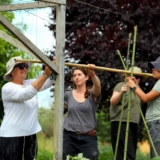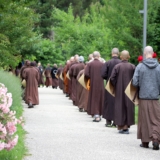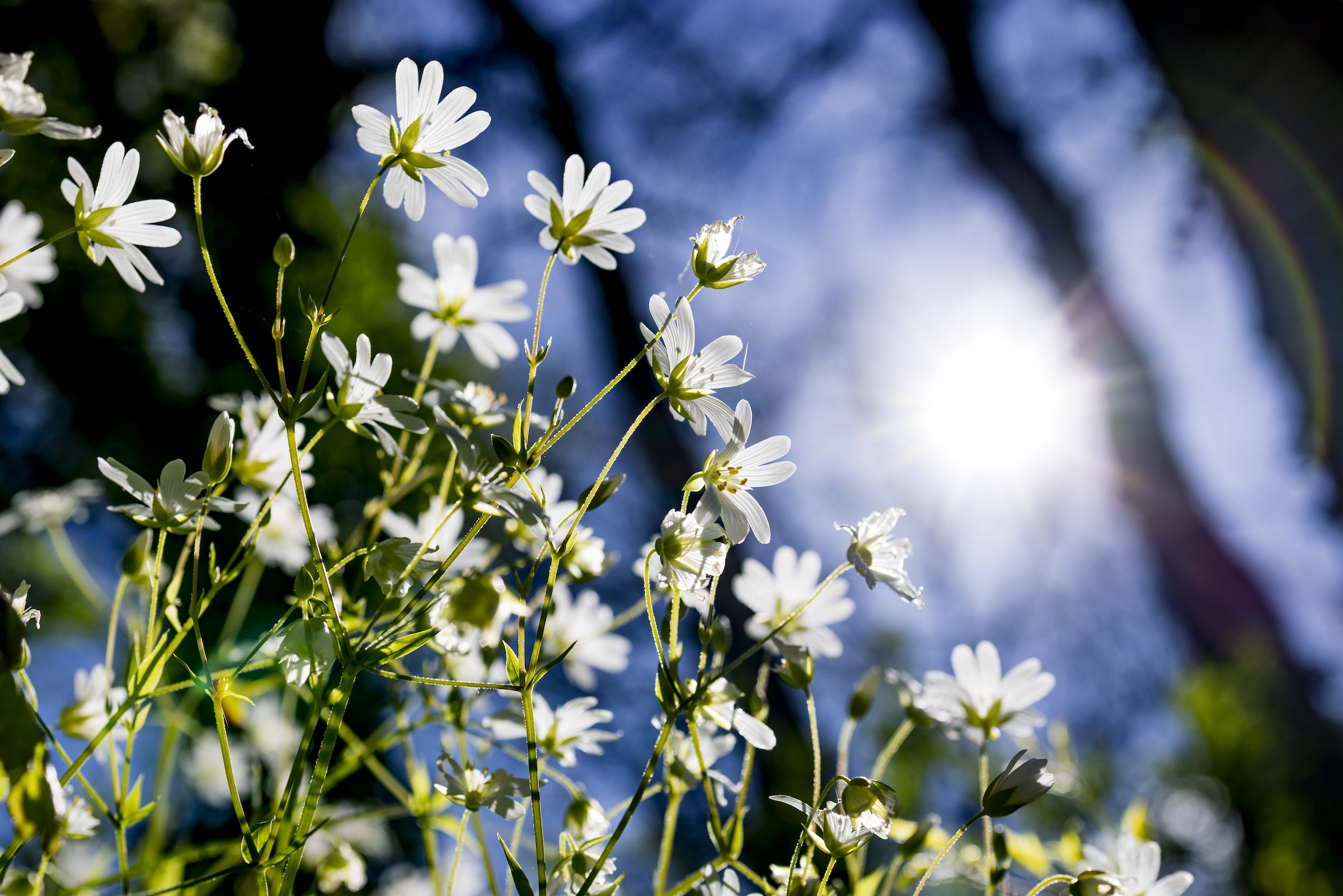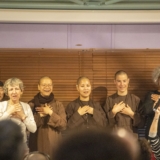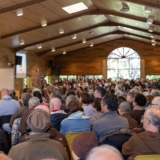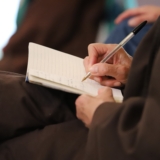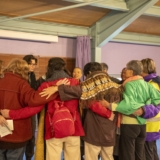(Thầy Chân Pháp Hữu)
Năm 2023, lần đầu tiên, một nhóm xuất sĩ Làng Mai tổ chức chuyến lưu diễn âm nhạc ở Bắc Mỹ với chủ đề “The Way Out Is In: A Musical Meditation” (tạm dịch Đường vào nội tâm: Âm nhạc thiền). Đây là một sự kết hợp đặc biệt giữa âm nhạc đương đại, thơ và những bài hướng dẫn thực tập súc tích và đầy cảm hứng. Chuyến lưu diễn bắt đầu từ ngày 21.04 tại Baltimore, đến Washington D.C. và Boston, kết thúc bằng một buổi hòa nhạc ở Toronto, Canada vào ngày 1.5. Dưới đây là những chia sẻ của thầy Pháp Hữu với BBT trong buổi ngồi chơi ngày 2.1.2024.
Tinh thần cởi mở và uyển chuyển
Khi bắt đầu chuyến lưu diễn, chúng tôi có ý định thiết kế những buổi nhạc thiền theo kiểu lồng âm nhạc vào câu chuyện dòng sông mà Thầy đã viết như một bài thơ, giống như nhiều buổi nhạc thiền chúng tôi từng tổ chức trong các khóa tu tại Làng Mai. Tuy nhiên, sư cô Hiến Nghiêm và tôi – hai người dẫn chương trình – nhận ra rằng có tới 90% số người trong thính chúng sẽ không hiểu được ý nghĩa của câu chuyện mang tính thiền quán này vì nó khá sâu. Chúng tôi cần phải giải thích ý nghĩa câu chuyện. Mô thức này phù hợp trong các khóa tu vì thính chúng là những thiền sinh và xuất sĩ, mọi người đã quen thuộc với hình ảnh “đi như một dòng sông”. Nhưng trong chuyến lưu diễn này, nhiều người đến tham dự vì họ nghe được thông tin từ bạn bè. Chúng tôi nhận thấy thơ của Thầy có lẽ không thích hợp với họ.
May mắn thay, một điểm nổi bật trong chuyến lưu diễn là chúng tôi thực tập với tinh thần cởi mở và uyển chuyển. Chúng tôi quyết định lồng những chia sẻ về chánh niệm và pháp môn thực tập thông qua những bài pháp thoại ngắn chừng năm bảy phút, dẫn dắt người nghe đến với âm nhạc. Điều này giúp thiết lập những nền tảng cơ bản cho toàn bộ buổi diễn. Chúng tôi bắt đầu bằng chia sẻ “Thầy là ai?”, bởi vì mục đích của chuyến lưu diễn là nhằm tôn vinh gia tài Thầy để lại. Sau đó, chúng tôi chia sẻ về tinh thần của đạo Bụt dấn thân, về sự sáng tạo và cởi mở của Thầy giúp mọi người có được niềm vui và hạnh phúc khi thực tập.
Hồi xưa ở Tây phương, rất nhiều người biết đến Thầy với vai trò một nhà hoạt động hòa bình và nhà thơ hơn là một vị xuất sĩ. Những bài thơ là phương tiện để Thầy truyền tải thông điệp của mình về hòa bình. Đoàn thể đầu tiên của Thầy là những thanh niên trẻ làm việc trong những ngôi làng bị chiến tranh tàn phá, chứng kiến cảnh giết chóc và bom đạn cày xới mỗi ngày. Đó là lý do hình thành những Ngày quán niệm trong truyền thống Làng Mai. Thầy nhận ra rằng chúng ta cần tới với nhau mỗi tuần một lần để cùng nhau trân quý những nhiệm mầu của cuộc sống – đạo Bụt chính là một nếp sống. Mỗi tuần chúng ta đến với nhau để thắp sáng ý thức về vẻ đẹp của giây phút hiện tại, đồng thời đem chánh niệm soi chiếu vào những khổ đau, nhìn sâu vào gốc rễ của chúng, ôm ấp và chuyển hóa chúng, cùng nhau vun trồng những tuệ giác mới và những hạt giống thiện lành trong tâm thức chúng ta.
Trong những ngày quán niệm, Thầy cho phép những bạn trẻ mang theo đàn và trống để chơi nhạc và cùng hát với nhau. Rất nhiều bài thơ của Thầy đã được phổ nhạc. Thầy cũng mời nhiều nghệ sĩ, nhạc sĩ, ca sĩ, nhà thơ tới tham dự, những người trở nên rất nổi tiếng ở Việt Nam sau này. Âm nhạc rất quan trọng đối với Thầy. Sáng tác nhạc là một trong những sở thích của Thầy. Bản thân Thầy cũng là một nghệ sĩ đầy tài năng.
Nhịp cầu đưa mọi người đến với con đường tâm linh
Sau phần giới thiệu về Thầy, chúng tôi chia sẻ về hơi thở ý thức bởi vì bài hát đầu tiên nói về mười sáu bài tập hơi thở ý thức. Chánh niệm luôn luôn là chánh niệm về cái gì, vì vậy sau đó chúng tôi nói tới chánh niệm về khổ đau, rồi dẫn tới bài hát Đêm nguyện cầu, lấy ý từ một bài thơ của Thầy. Đôi khi có tiếng đàn cello hoặc piano đệm vào những lời chia sẻ. Thích chúng được trải nghiệm những khoảnh khắc thiền quán sâu lắng trong sự hòa điệu giữa âm nhạc và thiền vị.
Chúng tôi rất may mắn vì trong nhóm có những vị xuất sĩ trước đây từng là nhạc công chuyên nghiệp, như thầy Pháp Linh chơi đàn cello và sư cô Trai Nghiêm chơi violin. Đây là sự trình diễn kết hợp giữa những bài hát với giai điệu, tiếng đàn, rap, trống theo phong cách pop, hip-hop; một sự kết hợp đa dạng và linh động tạo thành nhịp cầu giúp kết nối mọi người với đời sống tâm linh. Đối với những người thuộc thế hệ trẻ như chúng tôi, con đường tâm linh không đơn thuần là trở thành Phật tử hay đi theo một tôn giáo nào. Đời sống tâm linh là khả năng tỉnh thức ở mỗi người chúng ta, là học được nghệ thuật dừng lại, kết nối với khổ đau của chính chúng ta, ôm ấp, chăm sóc và chuyển hóa chúng với lòng từ bi.
Sau những buổi trình diễn, rất nhiều người chia sẻ rằng họ tiếp xúc được với năng lượng bình an và vững chãi rất sâu sắc. Vì chúng tôi là xuất sĩ, nhiều người nghĩ rằng âm nhạc của chúng tôi phải chậm rãi và thiền vị. Do đó, khi chúng tôi trình diễn bài hát có chút phong cách nhạc beat, chút phong cách rap, thính giả đã rất ngạc nhiên thốt lên “wow”. Họ không thể tin nổi đó là một phần của buổi trình diễn. Điều này giúp họ thay đổi cách nhìn và nhận ra rằng các xuất sĩ có thể tự do sáng tạo về cách thức truyền bá Phật pháp, chuyển tải ngôn ngữ của đạo Bụt, của chánh niệm và tỉnh thức vào đời sống xã hội. Hơn nữa, chuyến lưu diễn cũng giúp chính chúng tôi vượt thoát khỏi ý niệm cũ của mình về chúng tôi là ai. Chúng tôi thấy mình cần có can đảm để đi tới, miễn sao những hình thức nghệ thuật đó luôn gắn liền với những nguyên tắc và tuệ giác căn bản của đạo Bụt. Đây cũng chính là tuệ giác của Thầy.

“Đó là đạo Bụt của thầy”
Khi bắt đầu chuyến lưu diễn này, ai trong chúng tôi cũng lo ngại: Liệu chúng tôi có đủ khả năng không? Chúng tôi có tham vọng quá không? Đối với tôi, một trong những điểm nổi bật của chuyến lưu diễn này là niềm vui khi được khuyến khích làm một điều gì đó “khác lạ”. Điều này đòi hỏi niềm tin nơi Phật pháp và nơi Tăng thân. Từ sâu trong tim, tôi biết Thầy luôn ủng hộ chúng tôi.
Tôi nhớ trong khóa tu mùa Hè năm 2012, khi chúng tôi tổ chức lễ kỷ niệm 30 năm Làng Mai, theo qui tắc thông thường thì chúng tôi có thể biểu diễn những bài hát thật hay, nhưng không phải là hip-hop. Nhóm chúng tôi, những học trò còn trẻ tuổi của Thầy, lớn lên trong văn hóa hip-hop và pop, đánh liều thử xem sao. Chúng tôi muốn đem tới một không khí mới cho lễ kỷ niệm. Do đó chúng tôi luyện tập hai bài: một bài rap của Lupe Fiasco tên là The show goes on, nói về việc tiếp thêm sức mạnh cho những người đang đau khổ vì bị áp bức và kỳ thị; một bài khác của Jessi J và B.o.B tên là Price tag, nói về việc không bị cuốn hút bởi đời sống vật chất và chủ nghĩa tiêu thụ. Khi chúng tôi trình diễn hai bài hát, khán giả trở nên cuồng nhiệt một cách rất… chánh niệm. Gần như ai cũng yêu thích hai tiết mục đó.
Tuy nhiên, đây là một điều rất mới đối với văn hóa xuất sĩ. Vài người nhướng mày, tự hỏi “Chuyện gì xảy ra vậy? Việc này có được phép hay không?” và đi kể cho Thầy nghe. Vài ngày sau, tôi có cơ hội được ngồi uống trà với Thầy ở Sơn Cốc. Khi tôi bước vào, ánh mắt của Thầy như muốn nói “Chúng ta sẽ nói chuyện về việc con vừa làm đây”. Tôi ngồi xuống gần bên, Thầy nhìn tôi và nói: “Pháp Hữu, thầy nghe nói mấy hôm trước con và vài huynh đệ trẻ đã biểu diễn một bài hát không phù hợp với truyền thống chúng ta, và hình như các con còn nhảy nữa”. Tôi nhủ thầm: “Con không nghĩ là chúng con có nhảy”. Nhưng khi chúng tôi cảm nhận về nhạc điệu, cơ thể chúng tôi đã chuyển động theo. Do đó tôi trả lời: “Dạ, thưa Thầy, chúng con đã làm như vậy”. Thầy nói: “Một vài vị xuất sĩ có ý kiến và tới nói với thầy”.
Trong tâm trí của một vị xuất sĩ trẻ như tôi, tôi nghĩ rằng tôi đành phải từ bỏ việc này, tôi sẽ không bao giờ được phép biểu diễn loại hình âm nhạc như thế nữa. Nhưng Thầy nhìn tôi và nói: “Con có biết thầy đã trả lời thế nào không? Thầy nhìn những vị đó, mỉm cười và nói: Đó là đạo Bụt của thầy”. Đối với tôi, đây là một sự ghi nhận và chấp thuận lớn nhất mà một vị xuất sĩ trẻ có thể nhận được; Thầy đã tin tưởng chúng tôi. Thầy còn nói thêm: “Bây giờ là thời đại mới. Hãy để những người trẻ thể hiện bản thân bằng ngôn ngữ của chính họ, bằng trải nghiệm của chính họ về những gì có thể chạm tới trái tim họ”. Tôi nghĩ câu chuyện này thể hiện được sự sâu sắc, tình thương cũng như tầm nhìn của thầy chúng tôi.
Từ đó đến nay, chúng tôi đã biểu diễn với nhiều loại nhạc cụ khác nhau, và còn hát rap khi có sự hiện diện của Thầy trong nhiều dịp khác nữa, thậm chí với sự có mặt của chư Tôn đức đến từ Việt Nam. Đối với tôi, đây là một lời tuyên bố. Thầy muốn chỉ ra rằng đây là một hình thức của đời sống xuất sĩ Thầy muốn xây dựng và nuôi dưỡng giữa những người trẻ, những trái tim trẻ tràn đầy nhiệt huyết. Những người lớn tuổi hơn nên cho phép điều này được phát triển trong tăng thân theo tinh thần của sự thực tập, và cho phép những nhạc cụ trở thành một phần của đời sống xuất sĩ.
Tuệ giác của đạo Bụt đã được tiếp nối từ 2600 năm qua và tồn tại đến ngày nay nhờ sự thích nghi với văn hóa của từng thời đại. Trong lịch sử, chúng ta có thể thấy thơ văn, thư pháp, nghệ thuật làm vườn, võ thuật và âm nhạc đã được đưa vào trong rất nhiều truyền thống đạo Bụt. Ví dụ, ở Việt Nam, nhiều loại nhạc cụ đã được đưa vào trong khi tụng kinh. Ở Làng Mai, khi bắt đầu giới thiệu hình thức niệm danh hiệu Bồ tát Quan Thế Âm theo tiếng Phạn, chúng tôi chỉ sử dụng một cây đàn guitar và một chiếc trống. Sau đó, khi thầy Pháp Linh và sư cô Trai Nghiêm gia nhập tăng thân xuất sĩ, Thầy nói: “Đừng bỏ phí tài năng của con. Hãy sử dụng tài năng đó để truyền tải Phật pháp”. Kết quả là, những bài tụng kinh và bài hát của chúng tôi sau này có sử dụng cả cello, violin, piano, guitar, trống v.v.
Thầy từng nói rằng những việc chúng ta làm không phải là điều gì mới mẻ, thực ra điều này đã có trong truyền thống. Ví dụ, trống từng được sử dụng trong chiến trận để làm hiệu lệnh. Nhưng trống cũng được sử dụng làm trống Bát nhã trong những sự kiện quan trọng như lễ truyền giới. Chúng ta có thể sử dụng những chất liệu của truyền thống nhưng với một ý nghĩa mới, một mục đích mới mà nó vẫn có thể truyền tải sức mạnh của Phật pháp.
Hãy cười cùng tôi, hãy khóc cùng tôi
Chuyến lưu diễn cũng giúp tôi thực tập với nỗi buồn vì thiếu vắng hình bóng quen thuộc của Thầy. Một trong những bài hát tôi yêu thích là bài Unborn and Indestructible (Vô sinh và Bất diệt). Bài hát nói rằng không gì có thể mất đi. Ở Washington D.C., tôi đã khóc khi bài Unborn and Indestructible và bài Oneness (Nhất như) được cất lên. Khi nghe tới câu “hãy cười cùng tôi, hãy khóc cùng tôi” trong bài Oneness, trái tim tôi bỗng xúc động; tôi có thể lắng nghe và cảm nhận nỗi buồn của sự mất mát. Chánh niệm là khả năng nhận biết được điều gì đang hiện diện trong chúng ta, nhận diện nó và đủ can đảm ôm ấp nó. Chuyến lưu diễn giúp tôi nhận rõ tôi nhớ Thầy biết bao, tôi mong ước Thầy có thể hiện diện ở đó với chúng tôi. Tôi đã được trị liệu rất nhiều khi nhận ra rằng tôi không cần phải hoàn toàn chuyển hóa nỗi buồn mất Thầy, để có thể trở thành một vị giáo thọ thật sự vững chãi.

Đây là chuyến hoằng pháp lớn đầu tiên tại Mỹ sau khi Thầy viên tịch. Đây cũng là cơ hội cho chúng tôi – những vị giáo thọ trẻ trong đoàn – có những khoảnh khắc gắn bó thực sự. Chúng tôi hợp tác làm việc và phụng sự như một cơ thể. Không ai trong chúng tôi cố gắng để làm người lãnh đạo hoặc nổi bật hơn những người khác. Chúng tôi học cách làm việc hòa hợp với nhau như những ngón tay trên cùng một bàn tay. Thật mầu nhiệm! Nghệ sĩ đồng thời là ca sĩ nhạc rap Ofusu, tham gia cùng nhóm chúng tôi, đã nói: “Tôi chưa bao giờ tham dự một nhóm nào có sự đồng lòng và hòa điệu tuyệt vời như thế này”. Với tinh thần phụng sự, tình huynh đệ và sự hòa hợp, chuyến hoằng pháp này thể hiện được sự tiếp nối thực sự của Thầy.
Khi đến Boston, một trong những niềm vui lớn nhất của tôi là nhận được sự yểm trợ của sư cô Chân Không. Sau khi chúng tôi biểu diễn, tất cả khán giả đều đứng dậy, và sư cô Chân Không cũng đứng lên khỏi xe lăn để cùng tham gia tán thưởng. Thật là xúc động. Khi chúng tôi cúi chào khán giả, mọi người hô lên “Một bài nữa…một bài nữa…” và sư cô Chân Không cũng tán thành: “một bài nữa…một bài nữa…” Cả nhóm chúng tôi đi tới chỗ Sư cô và xá xuống đáp lễ. Chúng tôi giới thiệu với mọi người: “Hôm nay giữa chúng ta hiện diện một con người huyền thoại. Một trong những học trò đầu tiên của Thầy, một vị Bồ tát của thời đại chúng ta, và bây giờ Sư cô sẽ cúng dường đại chúng một món quà bất ngờ, bài hát The Smile (Nụ cười) – bài hát mà Sư cô luôn luôn hát trong những khóa tu của Thầy”. Khi Sư cô hát xong, đại chúng tán thưởng nhiệt liệt. Giây phút thật ấm lòng. Sư cô chia sẻ: “Sư cô rất vui vì vẫn còn sống để chứng kiến những khoảnh khắc này”. Tôi gần như muốn khóc khi nghe điều đó. Chúng tôi trình diễn buổi hòa nhạc cuối cùng tại trường Đại học Toronto, một phần tư khán giả là sinh viên, nhiều người trong số họ chưa bao giờ biết đến Làng Mai. Một bạn trẻ người Canada gốc Trung Hoa chia sẻ: “Đầu tiên, con muốn bày tỏ lòng biết ơn vì những điều quý thầy, quý sư cô hiến tặng. Con chưa bao giờ có những trải nghiệm như thế này. Xin quý thầy, quý sư cô giải thích cho con ý nghĩa của câu Namo’valo (Nam mô Bồ tát Quan Thế Âm), bởi vì khi nghe con đã khóc như một đứa trẻ. Con là một người trẻ 23 tuổi, cảm giác mờ mịt về tương lai phía trước, không có một đường hướng tâm linh, rồi bỗng nhiên con thấy mình đang khóc nức nở”. Tôi nói với người bạn trẻ: “Bạn đừng cố gắng để hiểu, mà hãy chỉ cảm nhận thôi. Bạn hãy tiếp xúc với những điều nằm sâu trong bạn, và nhiều khi ngôn từ không quan trọng và không cần thiết để giải thích những điều đó”.
Tìm album nhạc ở đâu?
Rất nhiều người hỏi chúng tôi: “Tôi có thể tìm album nhạc ở đâu? Tôi muốn nghe. Tôi muốn những bài hát này được đưa lên Spotify, hay trên Apple Music. Tôi muốn nghe những bài hát này khi lái xe đi làm, hoặc khi tôi có những cảm xúc mạnh. Tôi muốn sử dụng loại âm nhạc này để làm nơi nương tựa”. Thông thường, các ban nhạc cần có một album trước để mọi người biết đến họ, bởi vì khi mọi người thích âm nhạc của ban nhạc đó, họ sẽ muốn nghe những buổi trình diễn trực tiếp. Thành ra nhiều người không thể tin nổi chúng tôi không hề có album.
Một vài người rất yêu thích những bản nhạc mà chúng tôi trình bày và hỏi: “Có cách nào để những bài hát, những bản nhạc này có thể đến với nhiều người mà không chỉ giới hạn trong tăng thân Làng Mai? Cần có thêm điều kiện gì nữa để thực hiện được điều này?”. Sau một thời gian cùng quán chiếu với thầy Pháp Linh, chúng tôi nhận ra mình còn thiếu một nhà sản xuất âm nhạc. Chúng tôi có khả năng về âm nhạc, nhưng chúng tôi cần một ai đó giúp kết nối mọi thứ lại với nhau. Điều này dẫn đến một kết quả thật tuyệt vời sau chuyến lưu diễn: sự ra đời của một album nhạc mới tên là A cloud never dies (Đám mây không bao giờ chết), sẽ được phát hành vào mùa xuân 2024.
Nhà sản xuất album mới này là Jack Peñate, vốn là một nghệ sĩ đầy tài năng. Trong suốt thời gian ba tuần tiến hành ghi âm, chúng tôi thường xuyên ngồi lại với nhau, cùng thắp lên nén trầm, uống trà và chia sẻ những ước nguyện sâu kín nhất của mình. Ngồi trong thất Da Cóc và được ôm ấp bởi năng lượng tâm linh của Thầy, mọi thứ đều như được thấm nhuận chánh pháp Thầy truyền trao. Một khung cảnh thật huyền diệu. Chúng tôi mong muốn rằng âm nhạc có thể đưa mọi người vào một cuộc hành trình, một không gian để mọi người được cầu nguyện, được buồn đau, được cảm nhận bất cứ điều gì trong bản thân, và đồng thời nuôi hy vọng và cảm hứng để hành động. Đó là nguyện ước thâm sâu của chúng tôi.
Jack nhận ra chúng tôi có một chút vướng mắc vào những bản nhạc đã được trình bày trong chuyến lưu diễn. Anh khuyến khích chúng tôi nên buông bỏ những gì đã xảy ra, thưởng thức giây phút hiện tại bên nhau để tạo ra những cảm xúc tươi mới, để cho âm nhạc tuôn chảy thật tự nhiên.
Ban đầu, chúng tôi chuẩn bị tinh thần sẽ dành ra hẳn một năm để cho album được biểu hiện. Nhưng đến khoảng ngày thứ tám hay thứ mười, Jack và tôi nhìn nhau, tôi nói: “Tôi nghĩ chúng ta đã có một album, nó đang hình thành”. Jack nói: “Thầy Pháp Hữu, tôi không nói ra bởi vì tôi không muốn lạc quan quá sớm, nhưng tôi nghĩ thầy nói đúng. Nó đã hình thành. Thật tuyệt!”. Tôi chưa bao giờ gặp người nào tài năng và cũng rất khiêm cung như Jack. Anh còn trở lại Làng Mai vào dịp Ngày tiếp nối của Thầy và chơi đàn trong buổi hòa nhạc kết thúc khóa tu về biến đổi khí hậu. Khi chúng tôi mời anh tham dự, anh nói “đây quả là niềm vinh dự lớn nhất đối với tôi”, bởi vì anh nhận thấy đây chính là Tăng thân của anh, gia đình của anh, và anh muốn trở về nương tựa nơi vị thầy tâm linh vĩ đại ở đây.
Jack nói rằng điều anh học được từ âm nhạc và khoảng thời gian ở với chúng tôi là khả năng lãnh đạo với lòng từ bi. Anh nói: “Điều tôi học được là tình huynh đệ, sự đoàn kết, sự lãnh đạo với lòng từ bi, khả năng lắng nghe sâu, lời nói hòa ái, và sự tin tưởng, tiếp tục tin tưởng”. Đó cũng chính là những điều tôi học được từ lần làm việc chung này.
Có lần tôi chia sẻ với Jack về điều Thầy thường dạy chúng tôi: “Hãy để tổ tiên giúp chúng ta”. Tôi thật sự cảm nhận được rằng xuyên suốt chặng đường từ buổi hòa nhạc cho đến khi album biểu hiện, chúng tôi đã được yểm trợ rất nhiều từ tổ tiên, cả gia đình tâm linh và gia đình huyết thống. Con đường luôn luôn ở đó, nhưng đôi khi chúng ta cần phải quét dọn những cỏ cây lấp lối để con đường được hiển lộ thênh thang.







